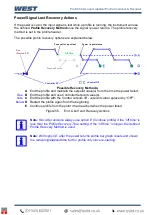
Pro-EC44 2-Loop Graphical Profile Controller & Recorder
Pro-EC44 Product Manual - 59540-2 September 2014
Page 88
If the instrument also has the data recorder option, its real time clock (RTC) expands the
profiling capabilities by adding Day & Time profile start options, releasing of hold segments at
a specific time of day and changing the power fail recovery option to one based on the length
of time the power has been off. These features are explained below and in the Profiler Setup
and Profile Control menus (
Profile Starting & Standard Segments
The example profile below explains the standard segment types required to make a simple
profile or profile sequence. A
Start Trigger
is the instruction to begin the selected profile.
This can be from the profile control menu, a digital input signal, via a serial communications
command or if enabled in the display configuration, the profile can be controlled from an
operator screen.
Following a Start Trigger,
profiles can start immediately, after a delay, or using the Day &
Time start timer (
Day & Time start available on with the Recorder option only
). Following the
start trigger, the remaining delay time or the start day & time are shown in the profile status
bar-graph until the profile begins running.
Note:
Profiles outside current setpoint limits will not
run, A “profile not valid” error
shows if you attempt to run a profile under these circumstances.
PROFILE 1
PROFILE 9
Seg. 1 Target SP
Ramp
(Time/Rate)
Starting Setpoint
Start
Trigger
Step
End
Timer or Delay Dwell
Join
(Profile 1 to Profile 9)
Figure 49.
Profile Starting and Standard Segment Types
Ramps and Step Segments have target setpoint that they will reach as they finish.
If a segment is a
Ramp-Time
type, the slope needed to reach the target setpoint in the
defined time will change depending on the starting setpoint value.
For a
Ramp-Rate
segment, the slope is defined by the segments Ramp Rate, so the time to
reach the target setpoint will change instead. This is of particular significance for the first
segment, since the starting value of the process may not be known in advance.
Note:
When using the instrument as a two loop profiler Ramp-Rate type
segments are not available. Calculate the time from the starting value to the
target setpoint and use Ramp-Time instead.
A
Dwell
(often called a
“soak”) holds the previous setpoint value for the specified dwell time.
Step
segments jump straight to the new target setpoint value.
An
End
segment ends the profile or profile sequence.
If the last segment is a
Join
, the
“join target” profile will begin running.
Содержание Pro-EC44
Страница 1: ...Pro EC44 2 Loop Graphical Profile Controller Recorder Pro EC44 User Guide 59540 2 ...
Страница 2: ......
Страница 6: ......
















































